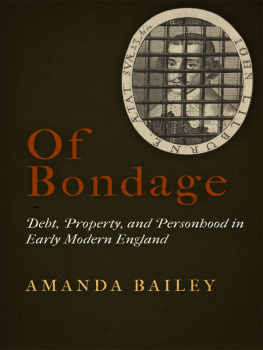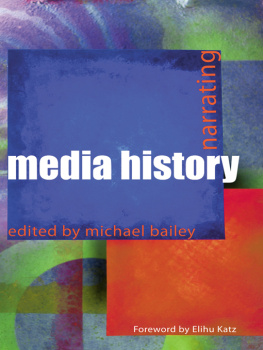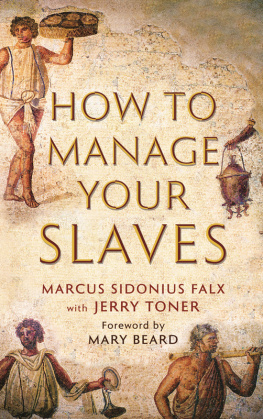All rights reserved. Except for brief quotations used for purposes of review or scholarly citation, none of this book may be reproduced in any form by any means without written permission from the publisher.
Of bondage : debt, property, and personhood in early modern England / Amanda Bailey. 1st ed.
p. cm.
Includes bibliographical references and index.
ISBN 978-0-8122-4516-5 (hardcover : alk. paper)
1. Debt in literature. 2. Economics and literatureGreat BritainHistory. 3. DebtGreat BritainHistory. 4. PropertyGreat BritainHistory. 5. English dramaEarly modern and Elizabethan, 1500-1600History and criticism. I. Title.
Preface

Poor Land in Jail as Companies Add Huge Fees for Probation reads a front-page New York Times headline on July 3, 2012. The article tells of the mushrooming of fines and fees levied by money-starved towns across the country and the for-profit businesses that administer the system, otherwise known as debt collectors. The result is that increasing numbers of poor peopleare ending up jailed and in debt for minor infractions. For instance, the unemployed Gina Ray, after receiving a $179 speeding fine, was imprisoned for defaulting on $1,500 in fees and interest from the original fine. On top of that, she was charged an additional amount for each day she spent incarcerated (forty in total). More than a third of U.S. states allow the police to haul people in who don't pay all manner of debts, from bills for health care services to credit card and auto loans, writes Alain Sherter of CBS Moneywatch.
The amount of the debt is hardly the issue. A 2010 report by the American Civil Liberties Union focusing on Georgia, Louisiana, Michigan, Ohio, and Washington found that people were being jailed at increasingly alarming rates over what started out as a minor fee. According to the ACLU, the sad truth is that debtors prisons are flourishing today, more than two decades after the Supreme Court prohibited imprisoning those who are too poor to pay their legal debts. In this era of shrinking budgets, state and local governments have turned aggressively to using the threat and reality of imprisonment to squeeze revenue out of the poorest defendants who appear in their courts.
This book comes out at a moment that mayor may notmark the end of the most dramatic economic recession in the United States since the 1930s, matched by a catastrophic insolvency for several major European nations. In the fall of 2008 we witnessed a financial crisis that brought the world to a halt. After having been led to believe that oversight of markets had been rendered impossible by high-tech securitizations and sophisticated fiscal innovations, it turned out that the events leading up to this meltdown in the United States were fairly straightforward and entirely avoidable: families had been sold mortgages on which they would inevitably default, which in turn resulted in the failing of major lenders like Lehman Brothers, and huge losses by Goldman Sachs and Citibank. Even as phrases such as commodity derivatives, collateralized mortgages, and hybrid securities dominated the national conversation, some attempted to reorient the public discourse and initiate a meaningful conversation about debt in the United States and the role of federal and state governments in determining the fate of the individual defaulter. The solution to this crisis, it turned out, was that the same government that bailed out financial institutions put the full force of law behind prosecuting insufficient citizens. To many, this turn of events seemed both shocking (it was) and unprecedented (perhaps not).
What endures across time and space is the flexibility of debt as a concept that underwrites morally murky ideologies and ethically ambiguous practices. David Graeber in Debt: The First 5,000 Years has provocatively suggested that the real origins of money are to be found in crime and recompense, war and slavery, honor, debt, and redemption. Graeber is my interlocutor throughout this book, as I seek to set his bold claims in historical context and test their validity in light of the ways that early moderns understood debt bondage, ways that fashioned the framework for thinking about forfeiture for the next four hundred years. The question that drives me is: What can the historical imagination of debt tell us about our present imaginary? My innovation, however, is to begin not with this question but rather with what I understand to be the answer: Institutions are able to protect creditors because the state assists them in penalizing debtors. Who could have ever imagined such a phenomenon?
Introduction: Bound Bodies and the Theater of Debt
Perhaps debt exists because we imagine it. It is the forms this imagining has takenand their impact on lived realitythat I would like to explore.
Margaret Atwood, Payback (2008)
The 1998 film Shakespeare in Love begins with the debtor in duress. Philip Henslowe, a businessman with a cash flow problem, is tied to a chair, while his creditors dangle his feet over burning coals. Unable to furnish the twelve pounds, one shilling, and four pence he borrowed, Henslowe obtains temporary release so that he may run to the garrett of Will Shakespeare. There, Henslowe begs Shakespeare for the long overdue playscript for which he provided him an advance. The profit the script will generate is Henslowe's only hope of repaying his creditors and avoiding prison. On first blush this is a broad sketch of a theatrical enterprise, not unlike present-day Hollywood, shaped by the vicissitudes of a credit economy. Upon closer inspection, however, this scene has much to tell us about the ways a particular monetary instrument, the early modern debt bond, realized the domain of money as a regime of power. Unable to collect their coins, Henslowe's creditors claim his body. While Henslowe, himself a creditor, relies on bonds to connect to wider commercial and social networks, his failure to honor his own will result in the breaking of all ties. A future of freedom or fetters hangs in the balance.
For twenty-first-century viewers, the slide from remuneration to retribution renders the inviolability of the person a tenuous prospect. How, though, would Henslowe's contemporaries have made sense of the debt bond's inexorable provision for payback? A borrower who made use of a sealed bond gave his creditor a formidable collection mechanism. If the obligation was not paid, the unsatisfied creditor could, without filing suit, proceed directly to execution of its terms, seizing his debtor's goods or lands, and in the case of insufficiency, his person. In early modern England, money was considered a form of property, which entailed tangible matter (res) and the intangible rights one had in respect to res. This meant that the exigencies of the bond inaugurated a legal relationnot only between creditor and debtor but also between the body of the debtor and the coins he borrowedthat at once confirmed and vitiated the Lockean assertion that Every man has a














